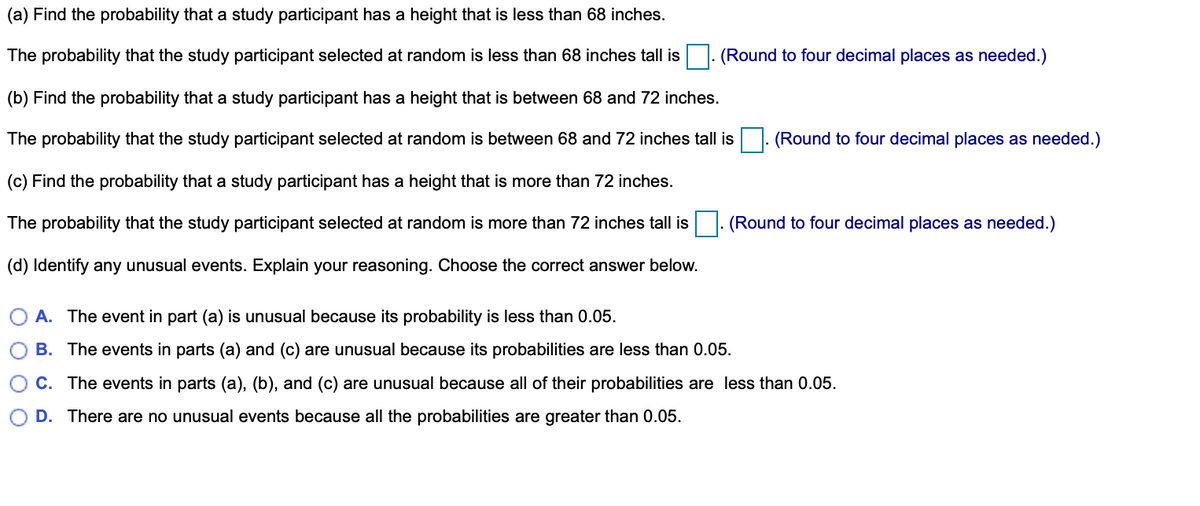(a) Find the probability that a study participant has a height that is less than 68 inches. The probability that the study participant selected at random is less than 68 inches tall is (Round to four decimal places as needed.) (b) Find the probability that a study participant has a height that is between 68 and 72 inches. The probability that the study participant selected at random is between 68 and 72 inches tall is. (Round to four decimal places as needed.) (c) Find the probability that a study participant has a height that is more than 72 inches. The probability that the study participant selected at random is more than 72 inches tall is. (Round to four decimal places as needed.) (d) Identify any unusual events. Explain your reasoning. Choose the correct answer below. O A. The event in part (a) is unusual because its probability is less than 0.05. O B. The events in parts (a) and (c) are unusual because its probabilities are less than 0.05. O C. The events in parts (a), (b), and (c) are unusual because all of their probabilities are less than 0.05. O D. There are no unusual events because all the probabilities are greater than 0.05.
(a) Find the probability that a study participant has a height that is less than 68 inches. The probability that the study participant selected at random is less than 68 inches tall is (Round to four decimal places as needed.) (b) Find the probability that a study participant has a height that is between 68 and 72 inches. The probability that the study participant selected at random is between 68 and 72 inches tall is. (Round to four decimal places as needed.) (c) Find the probability that a study participant has a height that is more than 72 inches. The probability that the study participant selected at random is more than 72 inches tall is. (Round to four decimal places as needed.) (d) Identify any unusual events. Explain your reasoning. Choose the correct answer below. O A. The event in part (a) is unusual because its probability is less than 0.05. O B. The events in parts (a) and (c) are unusual because its probabilities are less than 0.05. O C. The events in parts (a), (b), and (c) are unusual because all of their probabilities are less than 0.05. O D. There are no unusual events because all the probabilities are greater than 0.05.
Algebra and Trigonometry (MindTap Course List)
4th Edition
ISBN:9781305071742
Author:James Stewart, Lothar Redlin, Saleem Watson
Publisher:James Stewart, Lothar Redlin, Saleem Watson
Chapter14: Counting And Probability
Section14.2: Probability
Problem 3E: The conditional probability of E given that F occurs is P(EF)=___________. So in rolling a die the...
Related questions
Question
In a survey of a group of men, the heights in the 20-29 age group were

Transcribed Image Text:(a) Find the probability that a study participant has a height that is less than 68 inches.
The probability that the study participant selected at random is less than 68 inches tall is
|. (Round to four decimal places as needed.)
(b) Find the probability that a study participant has a height that is between 68 and 72 inches.
The probability that the study participant selected at random is between 68 and 72 inches tall is
(Round to four decimal places as needed.)
(c) Find the probability that a study participant has a height that is more than 72 inches.
The probability that the study participant selected at random is more than 72 inches tall is. (Round to four decimal places as needed.)
(d) Identify any unusual events. Explain your reasoning. Choose the correct answer below.
A. The event in part (a) is unusual because its probability is less than 0.05.
B. The events in parts (a) and (c) are unusual because its probabilities are less than 0.05.
C. The events in parts (a), (b), and (c) are unusual because all of their probabilities are less than 0.05.
D. There are no unusual events because all the probabilities are greater than 0.05.
Expert Solution
This question has been solved!
Explore an expertly crafted, step-by-step solution for a thorough understanding of key concepts.
This is a popular solution!
Trending now
This is a popular solution!
Step by step
Solved in 2 steps

Knowledge Booster
Learn more about
Need a deep-dive on the concept behind this application? Look no further. Learn more about this topic, statistics and related others by exploring similar questions and additional content below.Recommended textbooks for you

Algebra and Trigonometry (MindTap Course List)
Algebra
ISBN:
9781305071742
Author:
James Stewart, Lothar Redlin, Saleem Watson
Publisher:
Cengage Learning

College Algebra
Algebra
ISBN:
9781305115545
Author:
James Stewart, Lothar Redlin, Saleem Watson
Publisher:
Cengage Learning

College Algebra (MindTap Course List)
Algebra
ISBN:
9781305652231
Author:
R. David Gustafson, Jeff Hughes
Publisher:
Cengage Learning

Algebra and Trigonometry (MindTap Course List)
Algebra
ISBN:
9781305071742
Author:
James Stewart, Lothar Redlin, Saleem Watson
Publisher:
Cengage Learning

College Algebra
Algebra
ISBN:
9781305115545
Author:
James Stewart, Lothar Redlin, Saleem Watson
Publisher:
Cengage Learning

College Algebra (MindTap Course List)
Algebra
ISBN:
9781305652231
Author:
R. David Gustafson, Jeff Hughes
Publisher:
Cengage Learning

Algebra & Trigonometry with Analytic Geometry
Algebra
ISBN:
9781133382119
Author:
Swokowski
Publisher:
Cengage
